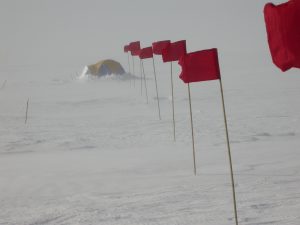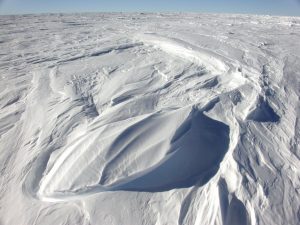25 June 2018
WASHINGTON — Tiny valleys near the top of Antarctica’s ice sheet reach temperatures of nearly minus 100 degrees Celsius (minus 148 degrees Fahrenheit) in the winter, a new study finds. The results could change scientists’ understanding of just how low temperatures can get at Earth’s surface, according to the researchers.
Scientists announced in 2013 they had found the lowest temperatures on Earth’s surface: Sensors on several Earth-observing satellites measured temperatures of minus 93 degrees Celsius (minus 135 degrees Fahrenheit) in several spots on the East Antarctic Plateau, a high snowy plateau in central Antarctica that encompasses the South Pole. But the researchers revised that initial study with new data and found the temperatures actually reach minus 98 degrees Celsius (minus 144 degrees Fahrenheit) during the southern polar night, mostly during July and August.
When the researchers first announced they had found the coldest temperatures on Earth five years ago, they determined that persistent clear skies and light winds are required for temperatures to dip this low. But the new study adds a twist to the story: Not only are clear skies necessary, but the air must also be extremely dry, because water vapor traps some heat in the air.
The researchers observed the ultra-low temperatures in small dips or hollows in the Antarctic Ice Sheet. The super cold, super dry air is denser than the slightly warmer air around it, so it falls into the hollows and becomes trapped. This allows the snow surface and the air above it to cool further, until the clear, calm, dry conditions change and the cold air mixes with warmer air higher in the atmosphere.
“In this area, we see periods of incredibly dry air, and this allows the heat from the surface of the snow to radiate into space more easily,” said Ted Scambos, a senior research scientist at the National Snow and Ice Data Center at the University of Colorado-Boulder and lead author of the new study in Geophysical Research Letters, a journal of the American Geophysical Union.
The record of minus 98 degrees Celsius is about as cold as it is possible to get at Earth’s surface, according to the researchers. For the temperature to drop that low, clear skies and dry air need to persist for several days. Temperatures could drop a little lower if the conditions lasted for several weeks, but that’s extremely unlikely to happen, Scambos said.

Blowing snow conditions at a camp site near Vostok Station in Antarctic summer.
Credit: Ted Scambos, NSIDC/University of Colorado-Boulder.
Finding the coldest place
The high elevation of the East Antarctic Plateau and its proximity to the South Pole give it the coldest climate of any region on Earth. The lowest air temperature ever measured by a weather station, minus 89 degrees Celsius (minus 128 degrees Fahrenheit), was recorded there at Russia’s Vostok Station in July 1983.
But weather stations can’t measure temperatures everywhere. So in 2013, Scambos and his colleagues decided to analyze data from several Earth-observing satellites to see if they could find temperatures on the plateau even lower than those recorded at Vostok.
In the new study, they analyzed satellite data collected during the Southern Hemisphere’s winter between 2004 and 2016. They used data from the MODIS instrument aboard NASA’s Terra and Aqua satellites as well as data from instruments on NOAA’s Polar Operational Environmental Satellites.
The researchers initially saw a broad region of the plateau more than 3,500 meters (11,000 feet) above sea level where temperatures regularly dropped below minus 90 degrees Celsius (minus 130 degrees Fahrenheit) at the snow surface. The lowest temperature they observed was minus 93 degrees Celsius (minus 135 degrees Fahrenheit).
Data from the MODIS instruments is calibrated using temperature measurements from weather stations on the ground. In 2016, NASA recalibrated the MODIS data with more up-to-date weather station measurements, and the researchers reanalyzed the temperature data. The weather conditions on the plateau did not change, but the adjusted satellite data gave the researchers a more accurate picture of what the actual lowest temperature was.
They found the record low was about 5 degrees Celsius (9 degrees Fahrenheit) colder than they originally reported, about minus 98 degrees Celsius (minus 144 degrees Fahrenheit).

Persistent winds shape the surface of East Antarctica’s snow into small dune forms called ‘sastrugi’.
Credit: Ted Scambos, NSIDC/University of Colorado-Boulder.
How cold can it get?
Scambos and his colleagues analyzed the terrain where they saw these ultra-low temperatures and found they occurred in small hollows 2 to 3 meters (6 to 9 feet) deep in the surface of the ice, on the southern side of high ridges on the plateau.
Interestingly, the researchers noticed a whole cluster of places where temperatures plunged almost exactly to that record low over the 14-year period, even though they were located hundreds of kilometers apart. That got them wondering: Is there a limit to how cold it can get on the plateau?
For the temperature to drop to that record low, skies must be clear and the air must be bone-dry for several days. After the temperature drops below a certain point, the air cools so slowly that it can’t get perceptibly colder before the weather conditions change, according to the researchers. Minus 98 degrees Celsius, then, appears to be the limit to how cold it can get at Earth’s surface, Scambos said.
“There’s a limit to how long the conditions persist to allow it to cool to these ultra-low temperatures, and a limit to how much heat you can actually get through the atmosphere, because water vapor has to be almost nonexistent in order to emit heat from the surface at these temperatures,” he said.
The research team has developed a set of instruments designed to survive and operate at the very coldest places throughout the winter to measure both snow and air temperatures. They are planning to deploy the instruments within the next two years.
###
The American Geophysical Union is dedicated to advancing the Earth and space sciences for the benefit of humanity through its scholarly publications, conferences, and outreach programs. AGU is a not-for-profit, professional, scientific organization representing 60,000 members in 137 countries. Join the conversation on Facebook, Twitter, YouTube, and our other social media channels.
Notes for Journalists
This paper is freely available for 30 days. Journalists and public information officers (PIOs) can download a PDF copy of the article by clicking on this link:
https://agupubs.onlinelibrary.wiley.com/doi/pdf/10.1029/2018GL078133
Journalists and PIOs may also request a copy of the final paper and multimedia by emailing Lauren Lipuma at [email protected]. Please provide your name, the name of your publication, and your phone number.
Neither the paper nor this press release is under embargo.
“Ultra-low surface temperatures in East Antarctica from satellite thermal infrared mapping: the coldest places on Earth”
Authors:
Ted A. Scambos, G. G. Campbell, A. Pope, T. Haran: National Snow and Ice Data Center, University of Colorado at Boulder, Boulder, Colorado, U.S.A.;
A. Muto: Department of Earth and Environmental Science, Temple University, Philadelphia, Pennsylvania, U.S.A.;
M. Lazzara: Antarctic Meteorological Research Center, University of Wisconsin-Madison and Madison Area Technical College, Madison, Wisconsin, U.S.A.;
C. H. Reijmer, M. R. van den Broeke: Institute for Marine and Atmospheric Research, Utrecht University, Utrecht, Netherlands.
Contact information for the authors:
Ted A. Scambos: [email protected], +1 (303) 492-1113
Lauren Lipuma
+1 (202) 777-7396
[email protected]